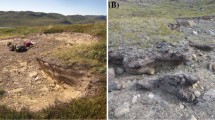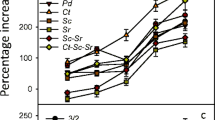Abstract
Aims
Biological soil crusts (biocrusts) are soil-surface communities in drylands, dominated by cyanobacteria, mosses, and lichens. They provide key ecosystem functions by increasing soil stability and influencing soil hydrologic, nutrient, and carbon cycles. Because of this, methods to reestablish biocrusts in damaged drylands are needed. Here we test the reintroduction of field-collected vs. greenhouse-cultured biocrusts for rehabilitation.
Methods
We collected biocrusts for 1) direct reapplication, and 2) artificial cultivation under varying hydration regimes. We added field-collected and cultivated biocrusts (with and without hardening treatments) to bare field plots and monitored establishment.
Results
Both field-collected and cultivated cyanobacteria increased cover dramatically during the experimental period. Cultivated biocrusts established more rapidly than field-collected biocrusts, attaining ~82% cover in only one year, but addition of field-collected biocrusts led to higher species richness, biomass (as assessed by chlorophyll a) and level of development. Mosses and lichens did not establish well in either case, but late successional cover was affected by hardening and culture conditions.
Conclusions
This study provides further evidence that it is possible to culture biocrust components from later successional materials and reestablish cultured organisms in the field. However, more research is needed into effective reclamation techniques.


Similar content being viewed by others
Abbreviations
- LOD:
-
Level of biocrust development
- UTTR:
-
Utah Test and Training Range
References
Antoninka AJ, Bowker MA, Reed SC, Doherty K (2015) Production of greenhouse-grown biocrust mosses and associated cyanobacteria to rehabilitate dryland soil function. Restor Ecol 24:324–335
Ayuso Velasco S, Giraldo Silva A, Nelson CJ, Barger NN, Garcia-Pichel F (2016) Microbial nursery production of high-quality biological soil crust biomass for restoration of degraded dryland soils. Appl Environ Microbiol. doi:10.1128/AEM.02179-16
Barger NN, Belnap J, Ojima DS, Mosier A (2005) NO gas loss from biologically crusted soils in Canyonlands National Park, Utah. Biogeochemistry 75:373–391
Barger NN, Castle SC, Dean GN (2013) Denitrification from nitrogen-fixing biologically crusted soils in a cool desert environment, southeast Utah, USA. Ecol Process 2:16–22
Belnap J (1993) Recovery rates of cryptobiotic crusts: inoculant use and assessment methods. Great Basin Nat 53:89–95
Belnap J, Eldridge, D, (2003) Disturbance and recovery of biological soil crusts. In: Belnap J, Lange OL (eds) Biological Soil Crusts: Structure, Function, and Management, Springer-Verlag, Berlin, pp 363-383
Belnap J, Lange OL (2003) Biological Soil Crusts: Structure, Function, and Management. Springer Verlag; Berlin
Belnap J, Phillips S, Troxler T (2006) Soil lichen and moss cover and species richness can be highly dynamic: the effects of invasion by the annual exotic grass Bromus tectorum, precipitation, and temperature on biological soil crusts in SE Utah. Appl Soil Ecol 32:63–76
Belnap J, Phillips SL, Witwicki DL, Miller ME (2008) Visually assessing the level of development and soils surface stability of cyanobacterially dominated biological soil crusts. Jour Arid Enivoron 72:1257–1264
Belnap J, Weber B, Büdel B (2016) Biocrusts as an organizing principle in drylands. In: Weber B, Büdel B, Belnap J (eds) Biological soil crusts: an organizing principle in drylands. Ecological Studies Series. Springer-Verlag, Berlin, pp 3–14
Bowker MA (2007) Biological soil crust rehabilitation in theory and practice: an underexploited opportunity. Restor Ecol 15:13–23
Bowker MA, Antoninka AJ (2016) Rapid ex situ culture of N-fixing soil lichens and biocrusts is enhanced by complementarity. Plant Soil 408:415–428
Bowker MA, Maestre FT, Escolar C (2010) Biological soil crusts as a model system for examining the diversity-ecosystem function relationship in soils. Soil Biol Biochem 42:405–417
Bu C, Wu S, Zheng M (2014) Identification of factors influencing restoration of cyanobacteria-dominated biological soil crusts. PLoS One. doi:10.1371/journal.pone.0090049
Castle SC, Morrison CD, Barger NN (2011) Extraction of chlorophyll a from biological soil crust: a comparison of solvents for spectrophotometric determination. Soil Biol Biochem 43:853–856
Chaudhary VB, Bowker MA, O’Dell TE, Grace JB, Redman AE, Rillig MC, Johnson NC (2009) Untangling the biological contributions to soil stability in semiarid shrublands. Ecol Appl 19:110–122
Chen YQ, Zhao YG, Ran MY (2009) Experimental research on artificial culture method of moss crust in hilly loess Plateau region. Acta bot Boreal-Occident sin 29:586–592
Chiquoine LP, Abella SR, Bowker MA (2016) Rapidly restoring biological soil crusts and ecosystem functions in a severely disturbed desert ecosystem. Ecol Appl 26:1260–1272
Condon LA, Pyke DA (2016) Filling the interspace- restoring arid land mosses: source populations, organic matter and overwintering govern success. Ecol Evol 0:1–10. doi:10.1002/ece3.2448
Davidson DW, Bowker M, George D, Phillips SL, Belnap J (2002) Treatment effects on performance of N-fixing lichens in disturbed soil crusts of the Colorado Plateau. Ecol Appl 12:1391–1405
Delgado-Baquerizo M, Maestre FT, Eldridge DJ, Bowker MA, Ochoa V, Gozalo B, Berdugo M, Val J, Singh BK (2016) Biocrust-forming mosses mitigate the negative impacts of increasing aridity on ecosystem multifunctionality in drylands. New Phytol 209:1540–1552. doi:10.1111/nph.13688
Doherty KD, Antoninka AJ, Bowker MA, Velasco Ayuso S, Johnson NC (2015) A novel approach to cultivate biocrusts for restoration and experimentation. Ecol Restor 33:13–16
Escolar C, Maestre FT, Martínez I, Bowker MA (2012) Warming reduces the growth and diversity of lichen-dominated biological soil crusts in a semi-arid environment: implications for ecosystem structure and function. Proc R Soc B 367:3087–3099
Faist AM, Herrick JE, Belnap J, Van Zee JW, Barger NN (2017) Biological soil crust and disturbance controls on surface hydrology in a semi-arid ecosystem. Ecosphere 8(3):e01691
Ferrenberg S, Reed SC, Belnap J (2015) Climate change and physical disturbance cause similar community shifts in biological soil crusts. Proc Nat Acad Science 112:12116–12121
Gao Q, Garcia-Pichel F (2011) Microbial ultraviolet sunscreens. Nat Rev Microbiol 9:791–802. doi:10.1038/nrmicro2649
Garcia-Pichel F, Pringault O (2016) Microbiology: cyanobacteria track water in desert soils. Nature 413:380–381
Grote EE, Belnap J, Housman DC, Sparks JP (2010) Carbon exchange in biological soil crust communities under different temperatures and soil water contents: implications for global change. Glob Chang Biol 16:2763–2774
Herrick JE, Whitford WG, de Soyza AG, Van Zee JW, Havstad KM, Seybold CA, Walton M (2001) Field soil aggregate stability kit for soil quality and rangeland health evaluations. Catena 44:27–35
Housman DC, Powers HH, Collins AD, Belnap J (2006) Carbon and nitrogen fixation differ between successional stages of biological soil crusts in the Colorado Plateau and Chihuahuan desert. J Arid Environ 66:620–634
Jonasson S (1983) The point intercept method for non-destructive estimation of biomass. Phytocoenologia 11:385–388
Lan S, Zhang Q, Wu L, Liu Y, Zhang D, Hu C (2013) Artificially accelerating the reversal of desertification; cyanobacterial inoculation facilitates the success of vegetation communities. Environ Sci Technol 48:307–315
Maestre FT, Martın N, Díez B, López-Poma R, Santos F, Luque I, Cortina J (2006) Watering, fertilization, and slurry inoculation promote recovery of biological crust function in degraded soils. Microb Ecol 52:365–377
Miller ME, Bowker MA, Reynolds R, Goldstein H (2012) Post-fire land treatments and wind erosion – lessons from the Milford flat fire. Aeolian Res 7:29–44
Painter TH, Deems J, Belnap J, Hamlet AF, Landry CC, Udall B (2010) Response of Colorado River runoff to dust radiative forcing in snow. Proc Natl Acad Sci 108:3854–3859
Reynolds JF, Stafford-Smith DM, Lambin E, Turner BL III, Mortimore M, Batterbury SPJ, Downing TE, Dowlatabadi T, Fernandez RJ, Herrick JE, Huber-Sannwald E, Jiang H, Leeman R, Lynam T, Maestre FT, Ayarza M, Walker B (2013) Global desertification: building a science for dryland development. Science 316:847–851
Rosentreter R, Eldridge DJ, Westberg M, Williams L, Grube M (2016) Structure, composition and function of biocrust lichen communites. In: Weber B, Büdel B, Belnap J (eds) Biological soil crusts: an organizing principle in drylands. Ecological Studies Series. Springer-Verlag, Berlin, pp 121–138
Rutherford WA, Painter TH, Ferrenberg S, Belnap J, Okin GS, Flagg C, Reed SC (2017) Albedo feedbacks to future climate via climate change impacts on dryland biocrusts. Sci Rep 7. doi:10.1038/srep44188
Seppelt RD, Downing AJ, Dean-Coe KK, Zhang Y, Zhang J (2016) Bryophytes within biological soil crusts. In: Weber B, Büdel B, Belnap J (eds) Biological soil crusts: an organizing principle in drylands. Ecological Studies Series. Springer-Verlag, Berlin, pp 101–120
Stark L, Brinda JC, McLetchie DN, Oliver MJ (2012) Extended periods of hydration do not elicit dehardening to desiccation-tolerance in regeneration trails of the moss Syntrichia caninervis. Int J Plant Sci 173:333–343
USDI BLM, United States Department of Interior, Bureau of Land Management (2007) Burned area emergency stabilization and rehabilitation hand-book. BLM Handbook H-1742-1. USDI BLM, Washington, D.C
Weber B, Bowker M, Zhang Y, Belnap J (2016) Natural recovery of biological soil crusts after disturbance. In: Weber B, Büdel B, Belnap J (eds) Biological soil crusts: an organizing principle in drylands. Ecological Studies Series. Springer-Verlag, Berlin, pp 479–498
Xiao B, Wang QH, Zhao YG et al (2011) Artificial culture of biological soil crusts and its effects on overland flow and infiltration under simulated rainfall. Appl Soil Ecol 48:11–17
Zhao Y, Bowker MA, Zhang Y, Zaady E (2016) Enhanced recovery of biological soil crusts after disturbance. In: Weber B, Büdel B, Belnap J (eds) Biological soil crusts: an organizing principle in drylands. Ecological Studies Series. Springer-Verlag, Berlin, pp 499–523
Wu N, Zhang YM, Downing A (2009) Comparative study of nitrogenase activity in different types of biological soil crusts in the Gurbantunggut Desert, Northwestern China. J Arid Environ 73(9):828-833
Acknowledgements
This work was partially supported by the Strategic Environmental Research and Development Program (Grant number RC- 2329; Department of Defense, Department of Energy, and Environmental Protection Agency). We also gratefully acknowledge facilitation of field site permitting and access at the Utah Test and Training Site by Russell Lawrence. We appreciate the help with field collections, greenhouse cultivation, preparation and field data collection by Akasha Faist, Dustin Kebble, Channing Laturno and Brook Stamper. We are also grateful for additional review provided by Akasha Faist, Kara Gibson and two anonymous reviewers that greatly improved the manuscript. Any use of trade, firm, or product names is for descriptive purposes only and does not imply endorsement by the U.S. Government.
Author information
Authors and Affiliations
Corresponding author
Additional information
Responsible Editor: Jayne Belnap.
Electronic supplementary material
ESM 1
(DOCX 222 kb)
Rights and permissions
About this article
Cite this article
Antoninka, A., Bowker, M.A., Chuckran, P. et al. Maximizing establishment and survivorship of field-collected and greenhouse-cultivated biocrusts in a semi-cold desert. Plant Soil 429, 213–225 (2018). https://doi.org/10.1007/s11104-017-3300-3
Received:
Accepted:
Published:
Issue Date:
DOI: https://doi.org/10.1007/s11104-017-3300-3




